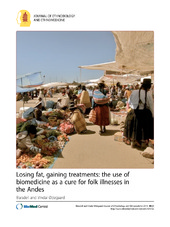| dc.description.abstract | Background: This article explores how people in the Andes incorporate beliefs from both biomedical and ethnomedical systems in treating folk illnesses that often involve spiritual beings. The article focuses on the kharisiri—one who is believed to steal fat and blood from unsuspecting humans to make exchanges with the devil. The kharisiri in turn is rewarded with good fortune. Victims of kharisiris, however, fall ill and may die if untreated. Historically, kharisiri victims relied on ethnomedicine for treatment, but it appears biomedical pills are now perceived by some as an effective treatment. By drawing on participants’ attitudes towards biomedicine, and how people in the Andes conceptualize health, this article theorizes as to why biomedical pills are sought to treat kharisiri attacks but not for other folk illnesses. Methods: Fieldwork was conducted in Arequipa and Yunguyo among market vendors, who make up a significant portion of Peru’s working population. This type of work increases the risk of different illnesses due to work conditions like exposure to extreme temperatures, long-distance travel, and social dynamics. Biomedical and ethnomedical products are often sold in and around marketplaces, making vendors a compelling group for exploring issues relating to treatment systems. Qualitative data was collected in 2011 with a follow-up visit in 2013. Participant observation, informal conversations, and unstructured interviews with 29 participants informed the study. Results: Participants unanimously reported that biomedical pills are not capable of treating folk illnesses such as susto and mal de ojo. Several participants reported that pharmaceutical pills can cure kharisiri victims. Conclusions: In comparison to other folk illnesses that involve spiritual beings, those who fall ill from a kharisiri attack lose physical elements (fat and blood) rather than their soul (ánimo) or becoming ill due to a misbalance in reciprocal relations—either with humans or non-human beings such as Pachamama. Because the kharisiri is typically a stranger to the victim, the Andean concept of reciprocity appears to be irrelevant in terms of preventing and treating attacks. The association between kharisiris, biomedicine, and exploitation may also play a role in the use of biomedical pills. | en_US |

